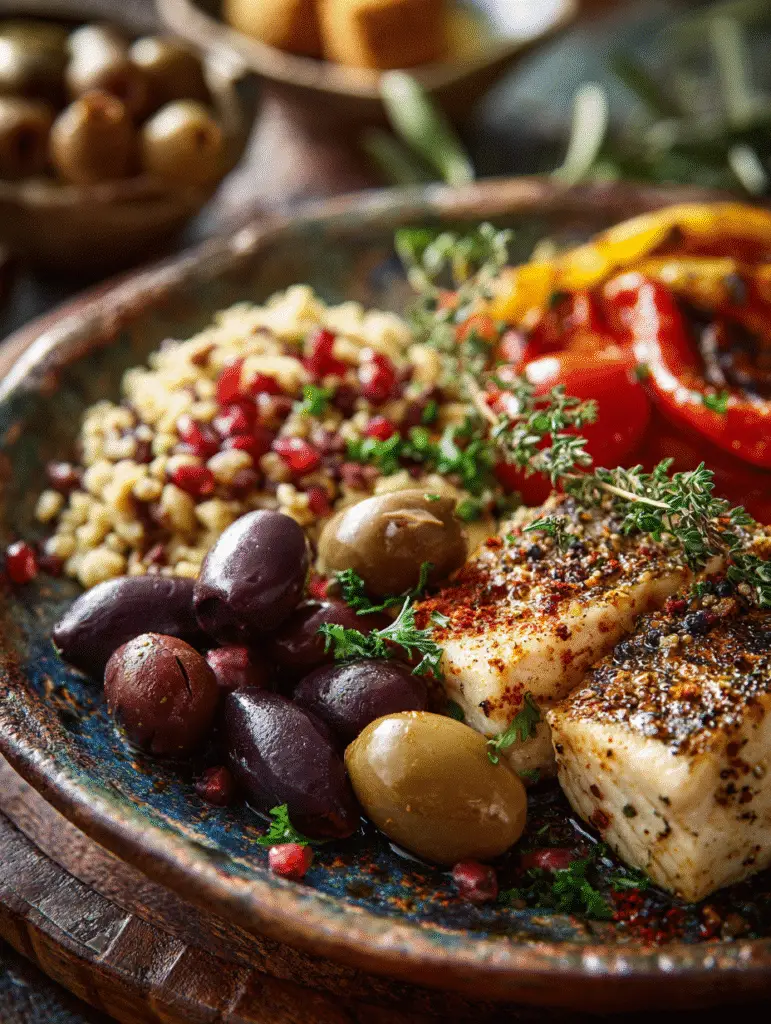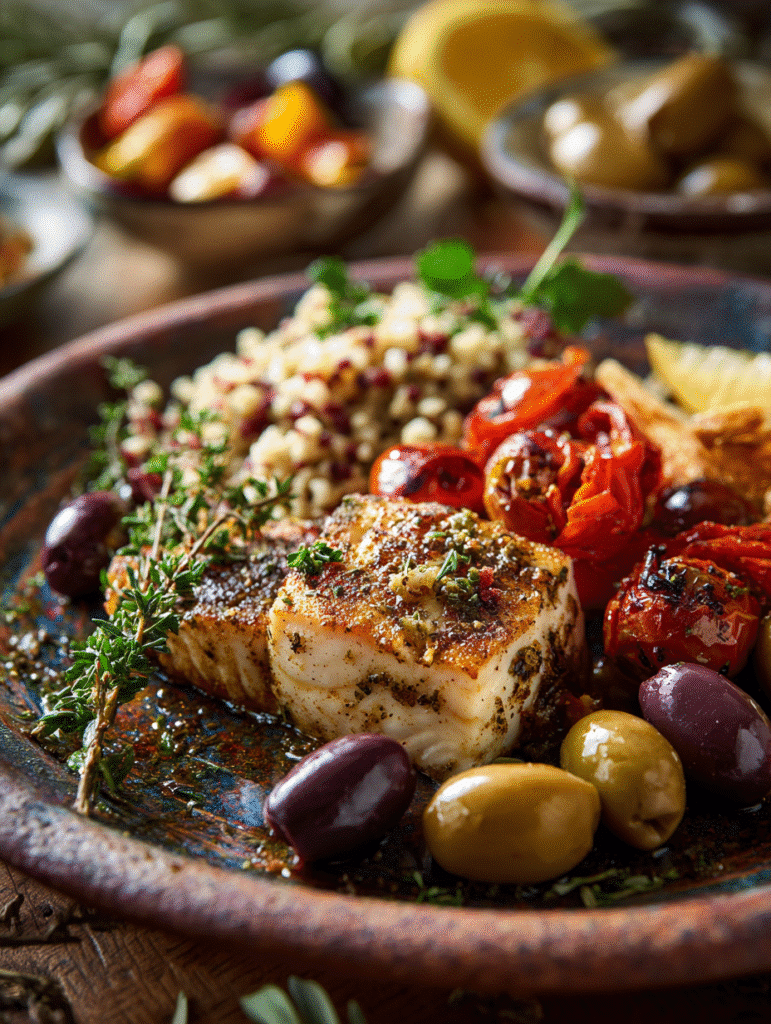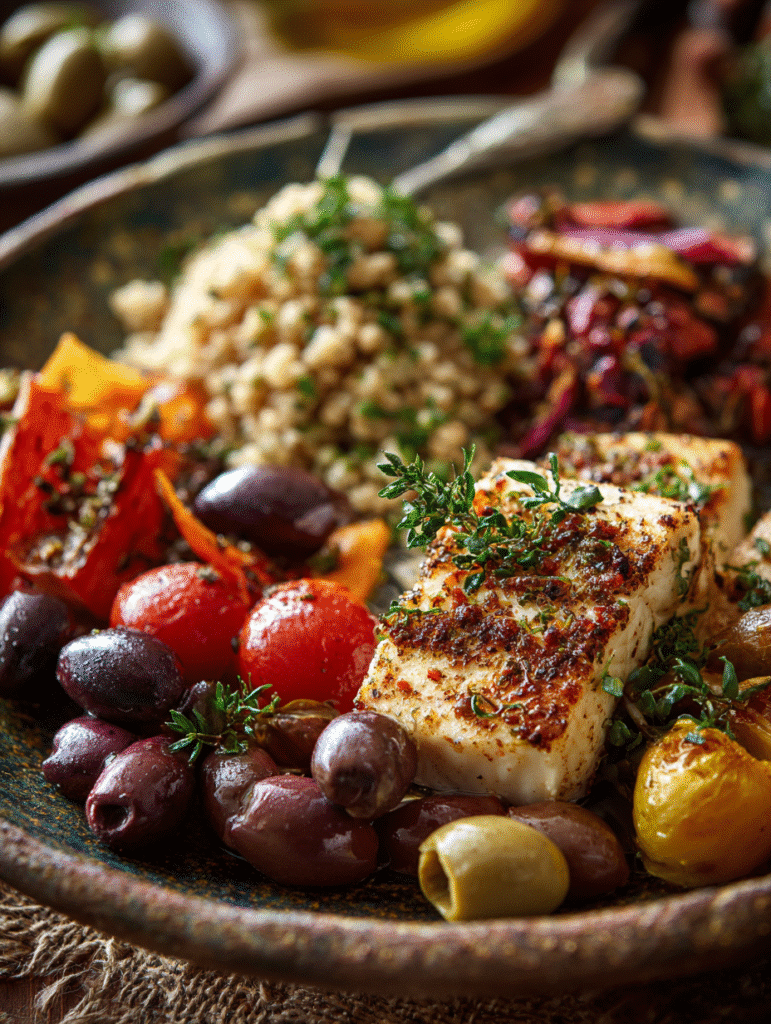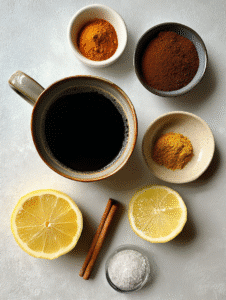Disclaimer: This content is for educational purposes only, not medical advice. Always consult with a doctor before making significant changes to your diet, especially if you have pre-existing health conditions.

If you’re searching for a Mediterranean diet food list that’s simple, complete, and real-life tested, you’re in the right place. As a chef, mama, and food-lover, I’ve followed this way of eating not just for the flavor, but for how good it makes me feel. In this article, I’ll walk you through the essential Mediterranean diet foods, why they matter, and how to build easy meals around them, whether you’re a beginner, pescatarian, or vegetarian.
In this Article
Key Takeaways: What You Need to Know
- The Mediterranean diet centers around whole, plant-based foods with healthy fats and lean proteins.
- You’ll enjoy fresh produce, legumes, whole grains, olive oil, nuts, fish, and herbs, with minimal processed foods.
- It’s backed by science for heart health, weight balance, and long-term wellness.
- This article includes a complete Mediterranean diet food list, vegetarian swaps, plus practical meal ideas.
My Story with the Mediterranean Diet
Why I Switched to a Mediterranean Way of Eating
Mediterranean diet food list became more than a search term for me when my doctor flagged my rising cholesterol in my early 30s. As someone who loves butter, bread, and creamy sauces, I wasn’t ready to say goodbye to flavor, but I knew something had to give. That’s when I turned to the Mediterranean diet, not a diet in the “restrictive” sense, but more like a blueprint for eating well and living longer.
What I found? I wasn’t missing anything. I was gaining more: more energy, more color on my plate, and more reasons to cook at home.
I began with a printable Mediterranean diet food list taped to the fridge and started building meals from there. With just a few pantry upgrades (olive oil, lentils, sardines) and a freezer stash of wild salmon, it clicked.
You don’t have to be perfect, just consistent. And deliciously curious.
What Are the Core Foods of the Mediterranean Diet?
The Mediterranean diet food list includes: vegetables, fruits, legumes, whole grains, fish, seafood, olive oil, nuts, seeds, herbs, and fermented dairy. These are the building blocks of Mediterranean living.
The core foods of the Mediterranean diet include vegetables, fruits, whole grains, legumes, olive oil, nuts, seeds, seafood, and herbs. These are eaten daily or weekly, with minimal red meat and processed food.
- I break down the basics over at What Is the Mediterranean Diet?
- Need weekly guidance? Check out my Mediterranean Diet Meal Plan
The Full Mediterranean Diet Food List (With Swaps & Tips)
What Are the Best Foods to Eat on a Mediterranean Diet?
The best Mediterranean diet foods include olive oil, leafy greens, tomatoes, beans, lentils, whole grains, fish, nuts, seeds, yogurt, and herbs. These provide fiber, healthy fats, and antioxidants while reducing processed food and sugar intake.
When I first started this journey, I needed a complete list of Mediterranean diet foods I could stick to. So, I built one based on what I already liked, what was available at my grocery store, and how often I realistically cooked each week.
Here’s a breakdown that you can print, pin, or stick on the fridge. I’ve included vegetarian Mediterranean diet food list options where helpful.
1. Vegetables (eat daily)
Leafy greens (spinach, arugula, kale)
Cucumbers, tomatoes, zucchini, eggplant
Bell peppers, onions, garlic, carrots
Vegetarian note: Build your plate around color. I roast a tray of zucchini, red onion, and cherry tomatoes every Sunday.
2. Fruits (eat daily)
Apples, oranges, berries
Figs, grapes, melon, pomegranates
Lemons and citrus for zest and brightness
Chef tip: Keep a bowl of washed citrus on the counter, it brightens any dish, even lentil soup.
3. Whole Grains (eat most days)
Farro, bulgur, barley
Quinoa, brown rice, whole wheat pasta
Sourdough bread, whole grain pita
Vegetarian swaps: Use quinoa or farro as a base for grain bowls with chickpeas and grilled veggies.
4. Legumes (3+ times a week)
Chickpeas, lentils, black beans, cannellini beans
Hummus and bean spreads
Why I love them: Inexpensive, filling, and easy to batch-cook. My go-to is a chickpea and tomato stew.
5. Healthy Fats (daily)
Extra virgin olive oil
Olives
Avocados (not traditional, but delicious and healthy)
Tahini
Note: Skip vegetable oils. Keep EVOO as your main fat. I even drizzle it on yogurt.
6. Seafood (2+ times a week)
Salmon, sardines, mackerel, trout
Shrimp, mussels, clams, calamari
The Mediterranean diet recommends eating fish and seafood at least two times per week, focusing on fatty fish like salmon and sardines rich in omega-3s.
7. Poultry, Eggs, and Dairy (moderate)
Eggs (up to 7 per week)
Greek yogurt, kefir, cheese like feta or halloumi
Occasional chicken or turkey
Vegetarian note: Use Greek yogurt for protein and creaminess in sauces, dips, and breakfast.
8. Herbs and Spices (daily)
Basil, mint, oregano, thyme, rosemary
Parsley, dill, cinnamon, cumin
These add life to every meal. I keep dried oregano and smoked paprika within reach always.
9. Nuts and Seeds (daily)
Almonds, walnuts, pistachios
Sunflower seeds, flaxseeds, chia seeds
Snack tip: Toasted almonds + dark chocolate = dessert done right.
10. Red Wine (optional, moderate)
If you drink, 1 glass a day with meals
Red is traditional, dry styles preferred
But no pressure! You can get all the Mediterranean diet benefits without alcohol.
What to Limit
Processed foods, added sugars, refined grains
Red meats (rarely), fried foods, sugary drinks
Butter and margarine, swap for olive oil instead
Where to Begin?
Start with one section, say, grains or beans. Build meals using what you already enjoy, and branch out. You don’t need to master it all in one week.
- Try your hand at real dishes on my Mediterranean Diet Recipes page
- If you’re new to seafood, this Mediterranean Diet Overview covers how to ease in gradually

Mediterranean Diet Benefits Backed by Science (and Life)
What Are the Benefits of Eating a Mediterranean Diet?
The Mediterranean diet supports heart health, reduces inflammation, aids weight balance, and may lower the risk of diabetes, Alzheimer’s, and certain cancers. It’s praised for its long-term sustainability and whole-food foundation.
When I switched to the Mediterranean diet, I expected better cholesterol. What I didn’t expect? Better sleep, less bloating, a clearer head, and that after-dinner crash just… vanished. Food started to feel like fuel again, not something I needed to “burn off” later.
Let’s break down why that happens, backed by research, not just my kitchen table.
1. Heart Health Is the #1 Win
Multiple studies show the Mediterranean diet lowers the risk of heart disease by improving cholesterol levels, lowering blood pressure, and reducing arterial plaque buildup.
The National Institutes of Health confirms that long-term adherence can reduce cardiovascular events by up to 30% in high-risk individuals.
Real-life? My bloodwork improved within 3 months. That was enough proof for me.
2. Anti-Inflammatory Powerhouse
Because this diet is rich in antioxidants, omega-3s, and fiber, and low in ultra-processed ingredients, it helps calm chronic inflammation, which is linked to everything from arthritis to depression.
Fresh herbs, olive oil, berries, fatty fish? All inflammation-fighters.
3. Brain & Cognitive Protection
The Mediterranean way of eating has been linked to a reduced risk of Alzheimer’s and age-related cognitive decline. This isn’t just from olive oil, it’s the whole pattern.
Chef tip: Mix walnuts into yogurt with berries for a double brain-boosting breakfast.
4. Digestive Harmony
Between the fiber from lentils and leafy greens, fermented dairy like kefir or Greek yogurt, and limited red meat, your gut gets a breather. If you’ve dealt with bloating or sluggish digestion, this diet can help without feeling restrictive.
5. Sustainable Weight Balance
There’s no calorie counting here. Just better food choices. Because meals are filling and blood sugar–friendly, most people find they naturally stop overeating.
I’ve never felt more in tune with my hunger cues, and I say that as someone who used to finish every meal overly full.
6. It’s Built for Real Life
What makes this diet stick isn’t willpower. It’s joy. You can share pasta, sip wine, enjoy dessert (yes, really), without guilt. That’s the magic.
And when something feels good, you’ll actually keep doing it.
- Curious about how to live this day-to-day? Explore my Mediterranean Diet Meal Plan for sample days and real meals.
How to Start the Mediterranean Diet (Even If You’re Busy)
How Do I Begin the Mediterranean Diet Without Getting Overwhelmed?
Start the Mediterranean diet by adding more vegetables, using olive oil as your main fat, eating seafood twice weekly, and replacing refined grains with whole grains. Begin with one small change each week for a sustainable transition.
I know firsthand that starting a new way of eating can feel like too much. When I first made the switch, I was working full-time, had a toddler in tow, and dinner had to be on the table in 30 minutes or less.
So, I made one shift per week. That was it.
Here’s the roadmap I used, and recommend to all my readers and cooking class students.
Week 1: Swap Your Fats
Trade butter and canola oil for extra virgin olive oil. Cook with it. Drizzle it on everything. Use it in salad dressings.
Personal Tip: I kept a bottle by the stove and one at the dinner table. It’s now second nature.
Week 2: Add One Vegetable to Every Meal
Scrambled eggs? Add spinach. Sandwich? Toss in cucumber and tomato. Dinner? Make a side salad or roast a tray of veggies.
This step alone will shift your plate toward a Mediterranean profile.
Week 3: Try a Fish Dish
Add a seafood meal once or twice this week, like a simple baked salmon with lemon and dill. Don’t overthink it.
Not sure where to start? Head over to my Mediterranean Diet Recipes for easy, family-friendly fish meals.
Week 4: Make One Bean-Based Meal
Think: lentil soup, white bean salad, chickpea stew, or hummus wraps. These are budget-friendly and super filling.
Real-life saver: I batch-cook lentils and keep them in the fridge for fast lunches.
Week 5: Go Whole Grain
Switch white rice for brown or farro. Try whole wheat pasta. Add quinoa to a salad. Keep it simple and consistent.
Week 6: Create a Weekly Menu (Repeat It!)
Choose 3 breakfasts, 3 lunches, and 4–5 dinners. Repeat them for a few weeks. You’ll save brainpower and money.
Need help? I’ve got a printable version in my Mediterranean Diet Meal Plan to take the guesswork out.
Real-Life Testimonial
“I started Abby’s Mediterranean food list plan after years of failed diets. I was skeptical at first, but now, six months later, I feel more energized and my cholesterol is down 40 points. I’ve even got my husband on board. He loves the lentil soup!”
— Jenna T., Austin, TX
Bonus Tip: Shop Smart Once a Week
Make a grocery list based on what you actually eat (not what looks good on Pinterest). Stick to the perimeter of the store, produce, seafood, dairy, bulk grains, and pantry staples.
Your Printable Mediterranean Diet Food List + Sample Menu
Can I Get a Printable Mediterranean Diet Food List with Meals?
Yes, a printable Mediterranean diet food list should include vegetables, fruits, legumes, whole grains, olive oil, fish, herbs, nuts, seeds, and fermented dairy. Pair this list with a sample menu to simplify meal planning.
Whether you’re heading to the grocery store, meal prepping on Sunday, or just sticking something on your fridge, having a Mediterranean diet food list printable is a game changer.
Below, you’ll find two handy tools:
- A full food list by category
- A real-life one-day Mediterranean menu
You can copy, print, or screenshot them for quick reference.
Complete Mediterranean Diet Food List (Printable Table)
| Food Group | Eat Often | Tips / Notes |
|---|---|---|
| Vegetables | Leafy greens, tomatoes, peppers, cucumbers, onions, zucchini, carrots | Raw, roasted, or sautéed |
| Fruits | Berries, apples, figs, grapes, citrus, melons | Fresh or in yogurt, smoothies |
| Whole Grains | Quinoa, brown rice, barley, farro, whole wheat pasta | Great base for bowls and salads |
| Legumes | Chickpeas, lentils, white beans, black beans | Use in soups, salads, and dips |
| Healthy Fats | Olive oil, olives, avocados, tahini | Use in cooking and dressings |
| Nuts & Seeds | Almonds, walnuts, sunflower seeds, chia | Top salads, oats, or eat as snacks |
| Seafood | Salmon, sardines, shrimp, trout, mussels | Eat 2–3 times per week |
| Dairy | Greek yogurt, kefir, feta, ricotta | Choose plain, unsweetened |
| Herbs/Spices | Oregano, mint, parsley, basil, cumin, cinnamon | Use daily for flavor and health |
| Protein (Other) | Eggs, chicken (limited), tofu, tempeh | Rotate with seafood or legumes |
| Optional | Red wine (1 glass/day), dark chocolate | In moderation, as desired |
One-Day Mediterranean Diet Menu Example
Here’s how a simple day might look on this plan. I eat like this at least 3 days a week, it’s doable, satisfying, and easy to prep.
Breakfast
- Greek yogurt with blueberries, walnuts, and honey
- Drizzle of olive oil (yes, trust me!)
- Green tea or black coffee
Lunch
- Farro and chickpea salad with cherry tomatoes, cucumbers, red onion, parsley, lemon-olive oil vinaigrette
- Side of hummus + whole wheat pita
Snack
- Sliced apple with almond butter
- Handful of roasted sunflower seeds
Dinner
- Baked salmon with garlic, lemon, and dill
- Roasted zucchini and bell peppers
- Small side of brown rice
- Glass of red wine (optional)
Dessert
- Fresh figs or a square of dark chocolate
Make It Vegetarian?
- Swap salmon for grilled tempeh or a veggie-packed lentil stew.
- Use dairy-free yogurt and add more legumes for protein.
- Build your full week with my Mediterranean Diet Meal Plan
- Explore more Mediterranean Diet Recipes for ideas like this menu
Mediterranean Diet for Every Lifestyle (Veg, Gluten-Free & Picky Eaters)
Can I Follow the Mediterranean Diet If I’m Vegetarian or Have Food Restrictions?
Yes, the Mediterranean diet is highly adaptable for vegetarians, gluten-free eaters, and families. Focus on plant-based proteins, gluten-free whole grains, and flavorful herbs and spices to suit individual needs.
If you’re anything like me, you’ve cooked for every kind of eater, kids who only want bread, friends who are gluten-free, and partners who “don’t do beans.” Good news? The Mediterranean diet food list is one of the most flexible ways to eat well without cooking five different meals.
Here’s how I make it work for different lifestyles and diets.
1. Vegetarian Mediterranean Diet Food List Swaps
Vegetarians can easily enjoy this way of eating by swapping seafood and poultry with these protein-packed options:
| Replace With | Vegetarian Mediterranean Proteins |
|---|---|
| Fish/Chicken | Lentils, chickpeas, white beans |
| Anchovies | Capers or olives for salty, umami pop |
| Yogurt | Plain coconut or almond yogurt |
| Feta Cheese | Crumbled tofu with lemon and herbs |
Meal tip: Make a lentil tomato stew with rosemary and olive oil, it’s hearty, rich, and hits every note.
2. Gluten-Free Mediterranean Diet Options
While traditional Mediterranean diets include wheat, it’s easy to go gluten-free and still enjoy all the benefits.
| Swap This | For This Gluten-Free Option |
|---|---|
| Couscous | Quinoa, millet, or rice |
| Whole wheat bread | Brown rice crackers or GF sourdough |
| Pasta | Lentil pasta, chickpea pasta |
Personal favorite: I love brown rice bowls with spiced chickpeas, grilled zucchini, and lemon-tahini sauce.
3. Feeding Picky Eaters (Especially Kids)
You don’t have to sell “Mediterranean” to a kid, just keep it familiar.
Ideas that work in my kitchen:
- Mini pita pizzas with tomato sauce and mozzarella
- Baked sweet potato wedges + hummus
- “Snack plate dinner” with cucumber, cheese, fruit, olives, and a hard-boiled egg
The best part? You can adjust flavor levels (like going lighter on garlic) without changing the whole meal.
4. Meal Prep for Different Diets in One Go
Here’s how I make one meal base work for multiple needs:
Meal base: Farro, chickpeas, roasted vegetables
- Add grilled salmon for pescatarians
- Add tofu or avocado for vegetarians
- Swap farro for quinoa for gluten-free eaters
Everyone gets a plate they’ll enjoy. No short-order cooking required

Making the Mediterranean Diet a Habit (That Actually Sticks)
How Can I Stick to the Mediterranean Diet Long-Term?
Stick to the Mediterranean diet by creating a repeatable meal routine, keeping key ingredients on hand, and focusing on simple, flavorful recipes. Building habits, not restrictions, is the key to sustainability.
So you’ve got the Mediterranean diet food list, your pantry’s stocked, and you’ve tried a few meals. But real talk? Life happens. Schedules get messy. Takeout happens. Kids refuse anything green.
I get it. The key is not perfection. It’s building habits that bend but don’t break.
Here’s how I’ve helped real readers (and myself!) make it stick long after the first grocery haul.
1. Use a Weekly Food “Framework”
Instead of meal planning every dish, create flexible categories:
| Day | Meal Framework |
|---|---|
| Monday | Grain bowl with veggies + beans |
| Tuesday | Seafood + roasted veggies |
| Wednesday | Soup or stew night (lentil, minestrone) |
| Thursday | Pasta night (whole wheat or gluten-free) |
| Friday | Mediterranean snack board |
| Saturday | Flex night (out or leftovers) |
| Sunday | Big salad + protein (egg, tuna, tofu) |
This lets you prep in batches, reduce waste, and avoid decision fatigue.
2. Keep a Mediterranean Pantry & Freezer
Always have these on hand:
Pantry: Olive oil, canned chickpeas, lentils, brown rice, whole grain pasta, garlic, tahini, spices
Freezer: Wild salmon, shrimp, peas, spinach, frozen lemon juice cubes
That way, even on wild days, you’ve got the foundation for a Mediterranean meal.
3. Make a 5-Recipe Rotation
Choose five recipes your family loves and keep those ingredients stocked. When you don’t want to think, just fall back on the greatest hits.
Need help? My readers love:
- Sheet pan salmon with lemon and oregano
- Greek salad bowls with farro and hummus
- Lentil and tomato stew with crusty bread
- Mediterranean chickpea pasta
- Yogurt parfaits with walnuts and figs
Find these and more in the Mediterranean Diet Recipes section.
4. Make Meals a Ritual, Not a Rush
In the Mediterranean lifestyle, meals aren’t just food, they’re connection.
Light a candle. Eat at the table. Put your phone down.
Even once or twice a week, this shifts the energy around food. You’ll feel fuller, happier, and more grounded.
Real-Life Review
“After Abby’s guide, I stopped trying to ‘be perfect’ and just started eating more real food. I now have a mini herb garden on my windowsill, and my kids are obsessed with roasted carrots. We eat better, argue less at dinner, and I’ve lost 12 pounds without even noticing. This is just how we eat now.”
— Rebecca L., Durham, NC
Your Mediterranean Toolkit
- [Complete Food List Printable] — Already included in Part 5
- Weekly Meal Plan Template — Available in this guide
- Easy Recipes Archive — Explore Now
FAQ: Quick Answers to Popular Questions
What are some of the best foods to eat on a Mediterranean diet?
Olive oil, leafy greens, tomatoes, beans, lentils, fish, whole grains, nuts, and herbs are staples. These foods nourish the body and reduce inflammation.
What are the core foods of the Mediterranean diet?
Vegetables, fruits, legumes, whole grains, healthy fats (especially olive oil), seafood, herbs, and fermented dairy make up the foundation.
What are some of the benefits of eating a Mediterranean diet?
Benefits include heart health, lower inflammation, weight balance, improved digestion, and reduced risk of chronic diseases like diabetes and Alzheimer’s.
What are the recommendations for fish and seafood intake on the Mediterranean diet?
Eat fish or seafood at least two times per week. Fatty fish like salmon and sardines offer heart-healthy omega-3s.
Conclusion: Eat Well, Live Well, One Bite at a Time
If there’s one thing I’ve learned, it’s this: the Mediterranean diet isn’t about being perfect. It’s about being present, with your food, your people, and your health.
Start small. Keep it simple. And remember, eating well should feel good, not hard.
I’m rooting for you from my kitchen to yours.
— Abby.



